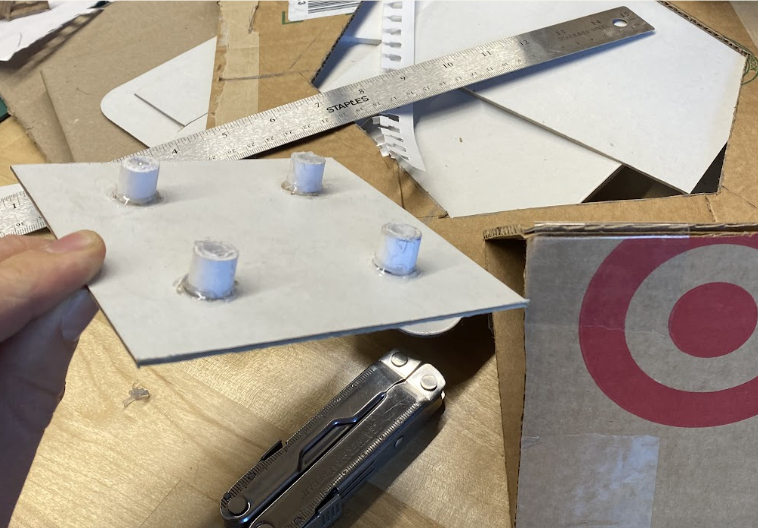Personal Planter
In a world post World War 3, this personal planter assists the rehabilitation of children in juvenile detention by providing them purpose and a creative outlet, to boost mental health.
PROBLEM IDENTIFICATION
Given the freedom to create an imagined reality 50 years from now, the team imagined that people would be dealing with the effects of a horrific world war that completely changed the social and physical landscape of the world. After some failed attempts at rebuilding a government, an exodus of Americans traveled to an abandoned town in Canada, renaming it The Big Maple. In this city-state, populated by refugees and their children, there is an emphasis on building a society with community values. Subsequently, a criminal justice system focused on rehabilitation rather than punishment was created.
IDEATION
The team then asked themselves what boosts their own mental health and came up with many activities including art, music, gardening, exercise, and cooking. Examining this list, gardening was decided on as it can provide juvenile offenders with a purpose and an outlet for self-expression as they can choose how their “garden” would look in their room. The first ideation was a clamp and light plant box (that could attach to a desk or window sill with clamps). This would be a plant box big enough to hold approximately 3 plants that users could plant and take care of. It would have a light attached to it so that the plants could grow despite the placement of the box in their room. The second ideation was a modular plant box where the user could pick and choose which shapes they would like to include in their plant box and how each shape is oriented. With this design, there would be a lego-style connecting piece that would be used to stack different plant containers on top of each other or next to each other with the top container being the ones with the actual plants. There would also be a peg board that the child can use to curate their planters vertically on a wall.
Once a thorough perspective of what the world would be like in 50 years was gained, the design process was started by identifying the problem statement. There were several aspects of this hypothetical world that seemed interesting to design for: small electric vehicles being the primary mode of transport within the city, the existence of a communal system for daycare and education, and a new juvenile justice system which had a focus on rehabilitation and education for re-entry to society. The team chose to pursue designing for juvenile detention after agreeing that this was the problem space that could lead to tangible products. This brought on the following problem statement: how can we keep young juvenile offenders mentally healthy by providing them purpose and self-expression for the sake of overall rehabilitation and re-entering of society?
To decide between the two ideations, a decision matrix was made. The criteria used was creativity/self expression, provides purpose, aesthetic, and the ability to grow plants. The scale was 1 to 5 and each criterion was weighted x3, x3, x1, and x2, respectively. Based on the results of the design matrix, the modular plant board was chosen to move forward with. Taking into consideration that every side of the container needs to have holes on each side, it was decided to include a tray at the bottom of the peg board which would catch any dirt or water that falls out of the plant containers. Additionally, the tray should be able to be taken off if the child wanted to put the planters in other places like on a desk. All in all, the product consisted of a pegboard with removable trays, several shapes of planter boxes, and connecting pieces.
PROTOTYPING
The goal of the low fidelity prototype was to determine the size of the plant containers, perfecting the peg system to form the best connections, and the drainage trays. The team first started prototyping the plant containers, determining their size. After playing around with the different possibilities of shapes, it was decided on squares, hexagons, and triangles. After this, the dimensions of the containers were made 5” by 5” with the idea that if each side was the same square size it would be easy to put together. The first attempt made at attaching boxes together was putting four holes in each side of the boxes and creating a 5” square that had pegs protruding on either side so it could connect two parts together.
Since this system worked well, attaching pieces tightly and efficiently, it was the inspiration to make a reverse peg board, with built-in pegs sticking out at regular intervals. This process was difficult with the materials available and a very low depth of functionality was achieved. While this is true, the pegboard was strong enough to hold up the empty boxes so the team could test their theory and see what it might look like.
The original plan for the water collection trays that could be detached and used to hold planter boxes away from the peg board was to create three trays that could be used separately. After creating the first iteration of this, it was clear that these were too small to hold more than one planter. Therefore, the second iteration was made with one tray which spanned the width of the entire peg board.










